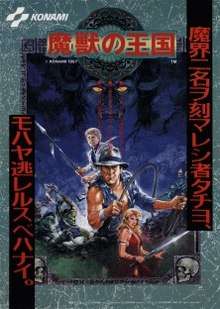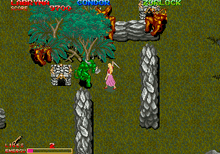Dark Adventure
Dark Adventure is a dimetric action-adventure game produced by Konami that was released for the arcades in North America in 1987.[3] It was the first arcade game by Konami that allowed up to three players simultaneously. The game was also released as Majū no Ōkoku (Japanese: 魔獣の王国, literally "The Kingdom of the Evil Beast") in Japan and as Devil World in other countries outside North America, although these versions feature significant gameplay differences and only allow up to two players.
| Dark Adventure | |
|---|---|
 Japanese arcade flyer | |
| Developer(s) | Konami |
| Publisher(s) | Konami |
| Platform(s) | Arcade |
| Release | |
| Genre(s) | Action-adventure game |
| Mode(s) | Up to 3 players simultaneously |
| Cabinet | Standard upright |
| Arcade system | CPU: 2 Motorola 68000s |
| Display | Raster |
Plot
An archeologist named Dr. Condor discovers the coffin of a demon in ancient ruins. During a press conference announcing his discovery, he decides to open the coffin for the first time, only to be transported into another world alongside a reporter named Labryna and another archeologist named Zorlock. The three heroes must now fight their way out of the Devil World in order to defeat the evil Demon King who is keeping them trapped and return to the human world.[4]
Gameplay

Dark Adventure can be played by up to three players, with a different character assigned to each control panel. Each character starts the game with a different default weapon: Labryna (the leftmost player) wields a sword, Condor (the center player) uses a whip, and Zorlock (the rightmost player) carries a spear. The controls for each player consist of an eight-way joystick to move their character and three action buttons for jumping, attacking and throwing dynamite. The dynamite throw button only works when the player has acquired the required power-up. There's also a map button that can be used by any of the three players. When held, the map button will pause the game and display the location of keys and exits in places explored by the player, although this function is not available in every area. The objective of the game is to pick up the keys and unlock exits until the player has reached the lair of the final boss. There are a total of 40 areas to explore. Enemy creatures include minotaurs, skeleton warriors, swamp monsters, man-eating trees, giant spiders and rats.
The game features both limited lives and a health gauge system. The player's health will gradually be drained as time goes by, even when the character is not sustaining any damage from enemies. The player must pick up soft drink cans to keep the health gauge filled and prevent the character from dying. If the player runs out of lives, every key in his or her possession will be dropped along with whatever weapon the character was last carrying, allowing another player to pick it up. Extra lives can be added to the player's stock by inserting more credit into the respective coin slot.
In addition to the default weapons, the player can also pick up a flamethrower or a laser gun, allowing the character to attack enemies from a safer distance. Other power-ups include a crystal ball that enhances melee weapons, a necklace that increases the player's walking speed, a shield that reduces the amount of damage taken by enemy attacks, and a magic orb that destroys all on-screen enemies.
Version differences
The Devil World/Majū no Ōkoku versions of the game feature the following differences from Dark Adventure.[4]
- The game can only be played by up to two players, since these versions were made as conversion kits for 2-player cabinets. Zorlock, the third player character, is absent as a result.
- The player character uses firearms instead of melee weapons as their default weapons. Labryna uses a bowgun, while Condor wields a pistol.
- Three additional firearms can also be obtained in addition to the laser gun and flamethrower. These consist of a machine gun, a shotgun and a bazooka.
- Dynamites are now thrown with the standard attack button instead of a dedicated button. This allows the player to use his or her main weapon while throwing dynamites at the same time.
- Instead of instant power-ups, the game uses a power-up selection meter similar to Gradius. By picking up blue power orbs, the cursor on the selection meter moves up by one level. When the cursor is on an item that the player wishes to use, he or she can obtain it by pressing the power-up button (which replaces the dynamite throw button). The two player characters have their power-up selection meters arranged differently.
- The map displays the whole area rather than just the portions already explored by the player.
- The player's health is drained at a much slower rate.
- Stages now have a much more linear structure, with almost all of them only having a single key and exit, preventing backtracking to previously cleared areas. The only exception is the thirteenth stage, Metropolis, which has numerous fake exits, including one that leads to the previous boss encounter, and a real exit. Every fourth stage now consists of a boss battle against a recurring two-headed draconic monster. Counting the dragon battles, Devil World/Majū no Ōkoku has a total of 19 stages, in contrast to the 40 stages in Dark Adventure.
- Credits cannot be used to add more lives during play. Continues are still allowed after both players run out of lives, but only up to three times per play. Continues will cease to be available once the final stage is reached.
- The ending of the game varies depending on certain conditions. One possible ending depicts the player being transported to the top of the Statue of Liberty after defeating the final boss (this is the only ending featured in Dark Adventure). The other ending shows the player stranded in the middle of the sea atop a floating raft.
- Devil World gives out points by the single or double digits, whereas Dark Adventure and Majū no Ōkoku have those same values multiplied by the hundreds.
Reception
In Japan, Game Machine listed Dark Adventure on their December 1, 1987 issue as being the fifteenth most-successful table arcade unit of the year.[5]
References
- "Dark Adventure Operator's Manual" (PDF). The Boneyard PDF Library. Konami. 1987. Retrieved 2014-09-03.
- Konami All Stars ~The 1000-Ryo Chest Heisei 4th Year Edition~ (Media notes). King Records. 1991. KICA-1053-5.
- "Dark Adventure". The International Arcade Museum. Retrieved 7 Oct 2013.
- "Devil's World Operator's Manual" (PDF). The Boneyard PDF Library. Konami. 1987. Retrieved 2014-09-02.
- "Game Machine's Best Hit Games 25 - テーブル型TVゲーム機 (Table Videos)". Game Machine (in Japanese). No. 321. Amusement Press, Inc. 1 December 1987. p. 25.